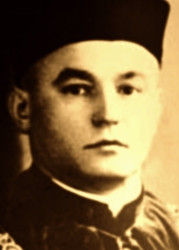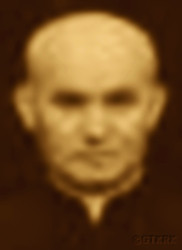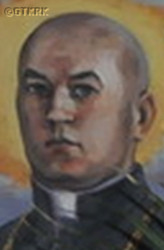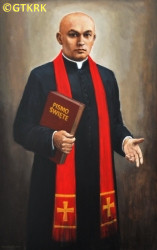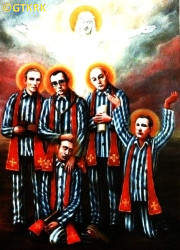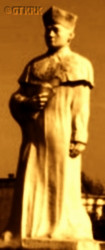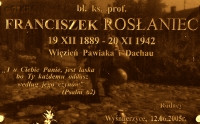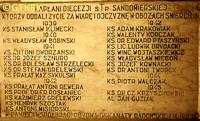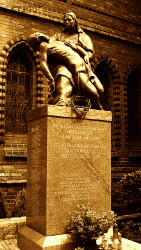Roman Catholic
St Sigismund parish
05-507 Słomczyn
85 Wiślana Str.
Konstancin deanery
Warsaw archdiocese, Poland
full list:
displayClick to display full list

searchClick to search full list by categories
wyświetlKliknij by wyświetlić pełną listę po polsku

szukajKliknij by przeszukać listę wg kategorii po polsku

Martyrology of the clergy — Poland
XX century (1914 – 1989)
personal data
religious status
blessed
surname
ROSŁANIEC
forename(s)
Francis (pl. Franciszek)
beatification date
13.06.1999more on
www.swzygmunt.knc.pl
[access: 2013.05.19]

the RC Pope John Paul IImore on
en.wikipedia.org
[access: 2014.09.21]
function
diocesan priest
creed
Latin (Roman Catholic) Church RCmore on
en.wikipedia.org
[access: 2014.09.21]
diocese / province
Sandomierz diocesemore on
en.wikipedia.org
[access: 2013.05.19]
academic distinctions
Habilitation Doctor of Bible Science
Doctor of Sacred Theology
Bachelor of Bible Science
honorary titles
honorary canonmore on
en.wikipedia.org
[access: 2014.11.14]
(Nativity of the Blessed Virgin Mary RC cathedral church, Sandomierztoday: Sandomierz urban gm., Sandomierz pov., Holy Cross voiv., Poland
more on
en.wikipedia.org
[access: 2021.09.29])
date and place
of death
14.10.1942

TA HartheimSchloss Hartheim „euthanasia” center
today: Alkoven, Eferding dist., Salzburg state, Austria
more on
en.wikipedia.org
[access: 2022.07.18]
alt. dates and places
of death
20.11.1942 (KL Dachau „death certificate” date)
details of death
In 1905 thrown out of his Gymnasium in Radom by Russian Tsarist authorities (during Poland's partition times) for participation in the school strike.
After German and Russian invasion of Poland in 09.1939 and start of the World War II, after start of German occupation, for the first time arrested by the Germans on 04.10.1939.
Jailed in Pawiak prison in Warsaw.
Next arrested by the Germans on 12.11.1939 for anti‐German leaflets that were found in his Salvator church.
Jailed in Daniłowiczowska Str. prison and from 16.04.1940 in Pawiak prison in Warsaw.
From there on 02‐04.05.1940 transported to KL Sachsenhausen concentration camp and next on 13‐14.12.1940to KL Dachau concentration camp.
Finally taken in a Germ. „Invalidentransport” (Eng. „Invalids' transport”) to TA Hartheim Euthanasia Center where perished murdered in a gas chamber.
According to the death certificate, prepared in KL Dachau, the „honest” otherwise German „medical doctors” and formalists — and at the same time, unrivaled fairy tale spinners — noted that the cause of death was Germ. „Lungenembolie bei Venenentzündung linken Bein” (Eng. „Pulmonary embolism, with phlebitis of the left leg”).
prisoner camp's numbers
22687Click to display source page (KL DachauClick to display the description), 024538 (KL SachsenhausenClick to display the description)
cause of death
extermination: gassing in a gas chamber
perpetrators
Germans
sites and events
TA HartheimClick to display the description, «Aktion T4»Click to display the description, KL DachauClick to display the description, KL SachsenhausenClick to display the description, Warsaw (Daniłowiczowska)Click to display the description, PawiakClick to display the description, GeneralgouvernementClick to display the description, Ribbentrop‐MolotovClick to display the description, Pius XI's encyclicalsClick to display the description
date and place
of birth
19.12.1889Birth certification on:
metryki.genbaza.pl
[access: 2025.09.17]

Wyśmierzycetoday: Wyśmierzyce gm., Białobrzegi pov., Masovia voiv., Poland
more on
en.wikipedia.org
[access: 2022.01.28]
parents
ROSŁANIEC Adam
🞲 1858, Wyśmierzycetoday: Wyśmierzyce gm., Białobrzegi pov., Masovia voiv., Poland
more on
en.wikipedia.org
[access: 2022.01.28] — 🕆 1920, ?

KAWIŃSKA Marianne
🞲 ?, ? — 🕆 ?, ?
baptism
26.12.1889Birth certification on:
metryki.genbaza.pl
[access: 2025.09.17]

Wyśmierzycetoday: Wyśmierzyce gm., Białobrzegi pov., Masovia voiv., Poland
more on
en.wikipedia.org
[access: 2022.01.28]
St Therese RC church
presbyter (holy orders)
ordination
10.06.1914

Rometoday: Rome prov., Lazio reg., Italy
more on
en.wikipedia.org
[access: 2021.12.18]
Most Holy Saviour, St John the Baptist and St John the Evangelist RC archbasilicamore on
en.wikipedia.org
[access: 2020.04.04] (in Lateran)
positions held
1920 – 1939
professor — Warsawtoday: Warsaw city pov., Masovia voiv., Poland
more on
en.wikipedia.org
[access: 2021.10.09] ⋄ Department of Catholic Theology, University of Warsaw [i.e. University of Warsaw (from 1945) / clandestine University (1939‐1945) / Joseph Piłsudski University (1935‐1939) / University of Warsaw (1915‐1935) / Imperial University of Warsaw (1870‐1915)] — lecturer in biblical theology, history of exegesis, archeology and biblical history; later in Palestinology, general introduction, biblical archaeology and exegesis of selected books of the New Testament; also: 1937‐1938, 1931‐1932 dean and 1938‐1939, 1932‐1933 deputy dean of the Department of Catholic Theology; 1934‐1935 secretary of the Polish Theological Society; chaplain of the Shelter at Belwederska Str.; chaplain and confessor of the Vestiary Sisters of Jesus WJ; confessor at the Educational Institute for Orphans at Bracka Str.
from 1928
supernumerary professor — Warsawtoday: Warsaw city pov., Masovia voiv., Poland
more on
en.wikipedia.org
[access: 2021.10.09] ⋄ University of Warsaw [i.e. University of Warsaw (from 1945) / clandestine University (1939‐1945) / Joseph Piłsudski University (1935‐1939) / University of Warsaw (1915‐1935) / Imperial University of Warsaw (1870‐1915)]
1920
postdoctoral degree (habilitation) — Warsawtoday: Warsaw city pov., Masovia voiv., Poland
more on
en.wikipedia.org
[access: 2021.10.09] ⋄ Department of Catholic Theology, University of Warsaw [i.e. University of Warsaw (from 1945) / clandestine University (1939‐1945) / Joseph Piłsudski University (1935‐1939) / University of Warsaw (1915‐1935) / Imperial University of Warsaw (1870‐1915)] — in „biblical realities”
1915 – 1918
student — Rometoday: Rome prov., Lazio reg., Italy
more on
en.wikipedia.org
[access: 2021.12.18] ⋄ biblical science, Pontifical Biblical Institute (Lat. Pontificium Institutum Biblicum), known as „Biblicum” (from 1909) — postgraduate specialised studies crowned with Biblical Science Batchelor's degree
1911 – 1915
PhD student — Rometoday: Rome prov., Lazio reg., Italy
more on
en.wikipedia.org
[access: 2021.12.18] ⋄ theology, „Gregorianum” [i.e. Lat. Pontificia Universitas Gregoriana (Eng. Pontifical Gregorian University)] — PhD thesis Lat. „Sensus genuinus et plenus locutionis Filius Hominis a Christo domino adhibitae” (Eng. „A genuine and full expression of the Son of Man expression used by Christ the Lord”), public defense 07.05.1915, ed. Vatican 1920
1905 – 1911
student — Sandomierztoday: Sandomierz urban gm., Sandomierz pov., Holy Cross voiv., Poland
more on
en.wikipedia.org
[access: 2021.09.29] ⋄ philosophy and theology, Theological Seminary
author of i.a. „Racism in the Light of the Teachings of St Paul : a theological–biblical treatise”, Warsaw 1939; „The Old Testament and Christianity : a theological–biblical treatise”, Warsaw 1936; „Christ, God, Man : Center of St. Paul's Theology : a theological–biblical treatise against the background of the exegesis of the letter to the Romans 1, 3, 4”, Włocławek 1928; „The Entry of the Israelites into the Land of Canaan in the Light of Law and Ethics”, Włocławek 1927; „St Thomas Aquinas as an Exegete: Against the Background of His Era”, Warsaw 1925; „The Origin and Historicity of the Books of the New Testament. The Religious Mission of the Israelite Nation”, Poznań 1924; „The Messiah According to the Prophecies of the Old Testament: A Theological and Biblical Study”, Warsaw 1923; popular science articles published in „Catholic Review” and „Priest's Voice”; participant in work on new editions of the Holy Scriptures translated by Fr Jacob Wujek
others related
in death
DULNYClick to display biography Thaddeus, LEŚNIOWSKIClick to display biography Stanislav Clement Charles, ŁĘGOSZClick to display biography James, MACIEJAKClick to display biography Thaddeus, MAZURKIEWICZClick to display biography Charles, MYSAKOWSKIClick to display biography Stanislav Francis, PANEKClick to display biography Joseph, PROKOPOWICZClick to display biography Theodore, ROSZKOWSKIClick to display biography Constantine Louis, SIUZDAKClick to display biography John, SZYMAŃSKIClick to display biography Felix
sites and events
descriptions
TA Hartheim: From 05.1940, in the Germ. Tötungsanstalt (Eng. Killing/Euthanasia Center) TA Hartheim, at the Schloss Hartheim castle in Alkoven in Upper Austria, belonging to KL Mauthausen‐Gusen complex of concentration camps, as part of «Aktion T4» program, the Germans murdered victims — people mentally retarded and disabled — in gas chambers with carbon monoxide. Till 24.08.1941 and the formal end of the «Aktion T4» program, c. 18,000 people were murdered in TA Hartheim. In 04.1941 the program was extended to include concentration camp prisoners. Most, if not all, of the murdered clergy from the KL Dachau concentration camp were taken to TA Hartheim in the so‐called Germ. „Invalidentransport” (Eng. „transport of invalids”), prisoners who were sick and, according to the Germans, „unable to work” (initially under the pretext of transfer to a better camp) — after the formal end of «Aktion T4» as part of the program codenamed «Aktion 14 f 13». It is estimated that at this stage — until 11.12.1944 — c. 12,000 prisoners were gassed at TA Hartheim.
Note: The dates of death of victims murdered in Schloss Hartheim indicated in the „White Book” are the dates of deportations from the last concentration camp the victims where held in. The real dates of death are unknown — apart from c. 49 priests whose names were included in the niem. „Invalidentransports”, but who did not arrive at TA Hartheim. Prob. perished on the day of transport, somewhere between KL Dachau and Munich, and their bodies were thrown out of the transport and cremated in Munich. The investigation conducted by Polish Institute of National Remembrance IPN concluded, that the other victims were murdered immediately upon arrival in Schloss Hartheim, bodies cremated and the ashes spread over local fields and into Danube river. In order to hide details of the genocide Germans falsified both dates of death (for instance those entered into KL Dachau concentration camp books, which are presented in „White Book” as alternative dates of death) and their causes. (more on: ipn.gov.plClick to attempt to display webpage
[access: 2019.05.30], en.wikipedia.orgClick to attempt to display webpage
[access: 2019.05.30])
«Aktion T4»: German state euthanasia program, systematic murder of people mentally retarded, chronically, mentally and neurologically ill — „elimination of live not worth living” (Germ. „Vernichtung von lebensunwertem Leben”). At a peak, in 1940‐1941, c. 70,000 people were murdered, including patients of psychiatric hospitals in German occupied Poland — German formalists noted then that, among others, „performing disinfection [i.e. gassing] of 70,273 people with a life expectancy of up to 10 years saved food in the amount of 141,775,573.80 Deutschmark”. From 04.1941 also mentally ill and „disabled” (i.e. unable to work) prisoners held in German concentration camps were included in the program — denoted then as «Aktion 14 f 13». C. 20,000 inmates were then murdered, including Polish Catholic priests held in KL Dachau concentration camp, who were murdered in Hartheim gas chambers. The other „regional extension” of «Aktion T4» was «Aktion Brandt» program during which Germans murdered chronically ill patients in order to make space for wounded soldiers. It is estimated that at least 30,000 were murdered in this program. (more on: en.wikipedia.orgClick to attempt to display webpage
[access: 2014.10.31])
KL Dachau: KL Dachau in German Bavaria, set up in 1933, became the main German Germ. Konzentrationslager (Eng. concentration camp) KL for Catholic priests and religious during World War II: On c. 09.11.1940, Reichsführer‐SS Heinrich Himmler, head of the SS, Gestapo and German police, as a result of the Vatican's intervention, decided to transfer all clergymen detained in various concentration camps to KL Dachau camp. The first major transports took place on 08.12.1940. In KL Dachau Germans held approx. 3,000 priests, including 1,800 Poles. The priests were forced to slave labor in the Germ. „Die Plantage” — the largest herb garden in Europe, managed by the genocidal SS, consisting of many greenhouses, laboratory buildings and arable land, where experiments with new natural medicines were conducted — for many hours, without breaks, without protective clothing, no food. They slaved in construction, e.g. of camp's crematorium. In the barracks ruled hunger, freezing cold in the winter and suffocating heat during the summer, especially acute in 1941‐1942. Prisoners suffered from bouts of illnesses, including tuberculosis. Many were victims of murderous „medical experiments” — in 11.1942 c. 20 were given phlegmon injections; in 07.1942 to 05.1944 c. 120 were used by for malaria experiments. More than 750 Polish clerics where murdered by the Germans, some brought to TA Hartheim euthanasia centre set up in Schloss Hartheim in Austria and murdered in gas chambers. At its peak KL Dachau concentration camps’ system had nearly 100 slave labour sub‐camps located throughout southern Germany and Austria. There were c. 32,000 documented deaths at the camp, and thousands perished without a trace. C. 10,000 of the 30,000 inmates were found sick at the time of liberation, on 29.04.1945, by the USA troops… (more on: www.kz-gedenkstaette-dachau.deClick to attempt to display webpage
[access: 2013.08.10], en.wikipedia.orgClick to attempt to display webpage
[access: 2016.05.30])
KL Sachsenhausen: In Germ. Konzentrationslager (Eng. concentration camp) KL Sachsenhausen, set up in the former Olympic village in 07.1936, hundreds of Polish priests were held in 1940, before being transported to KL Dachau. Some of them perished in KL Sachsenhausen. Murderous medical experiments on prisoners were carried out in the camp. In 1942‐1944 c. 140 prisoners slaved at manufacturing false British pounds, passports, visas, stamps and other documents. Other prisoners also had to do slave work, for Heinkel aircraft manufacturer, AEG and Siemens among others. On average c. 50,000 prisoners were held at any time. Altogether more than 200,000 inmates were in jailed in KL Sachsenhausen and its branched, out of which tens of thousands perished. Prior to Russian arrival mass evacuation was ordered by the Germans and c. 80,000 prisoners were marched west in so‐called „death marches” to other camps, i.e. KL Mauthausen‐Gusen and KL Bergen‐Belsen. The camp got liberated on 22.04.1945. After end of armed hostilities Germans set up there secret camp for German prisoners and „suspicious” Russian soldiers. (more on: en.wikipedia.orgClick to attempt to display webpage
[access: 2018.11.18])
Warsaw (Daniłowiczowska): Warsaw central detention centre — so‐called Centralniak — used by the Germans during occupation of Poland as a court prison where people suspected of political crimes where held. Many were subsequently taken to villages n. Warsaw (e.g. Magdalenka and Anin) and executed. (more on: pl.wikipedia.orgClick to attempt to display webpage
[access: 2013.08.17])
Pawiak: Investigative prison in Warsaw, built by the Russian occupiers of Poland in 1830‐1835. During the Poland partition's period, a Russian investigative prison, both criminal and political. During World War II and the German occupation, the largest German prison in the Germ. Generalgouvernement (Eng. General Governorate). Initially, it was subordinate to the Justice Department of the General Governorate, and from 03.1940 Germ. Sicherheitspolizei und des Sicherheitsdienst (Eng. Security Police and Security Service) of the Warsaw District — in particular the German Secret Political Police Gestapo. c. 3,000 prisoners were kept in Pawiak permanently, of which about 2,200 in the men's unit and c. 800 in the women's unit (the so‐called Serbia) — with a „capacity” of c. 1,000 prisoners. In total, in the years 1939‐1944, c. 100,000 Poles passed through the prison, of which c. 37,000 were murdered in executions — from 10.1943 Pawiak prisoners were murdered in open executions on the streets of Warsaw (sometimes several times a day) — during interrogations, in cells or in a prison „hospital”, and c. 60,000 were taken in 95 transports to concentration camps (mainly KL Auischwitz), other places of isolation or to forced labor. The prison Germans demolished during the Warsaw Uprising in 08‐10.1944. (more on: en.wikipedia.orgClick to attempt to display webpage
[access: 2022.08.17])
Generalgouvernement: After the Polish defeat in the 09.1939 campaign, which was the result of the Ribbentrop‐Molotov Pact and constituted the first stage of World War II, and the beginning of German occupation in part of Poland (in the other, eastern part of Poland, the Russian occupation began), the Germans divided the occupied Polish territory into five main regions. In two of them new German provinces were created, two other were incorporated into other provinces. However, the fifth part was treated separately, and in a political sense it was supposed to recreate the German idea from 1915 (during World War I, after the defeat of the Russians in the Battle of Gorlice in 05.1915) of creating a Polish enclave within Germany. Illegal in the sense of international law, i.e. Hague Convention, and public law, managed by the Germans according to separate laws — especially established for the Polish Germ. Untermenschen (Eng. subhumans) — till the Russian offensive in 1945 it constituted part of the Germ. Großdeutschland (Eng. Greater Germany). Till 31.07.1940 formally called Germ. Generalgouvernement für die besetzten polnischen Gebiete (Eng. General Government for the occupied Polish lands) — later simply Germ. Generalgouvernement (Eng. General Governorate), as in the years 1915‐1918. From 07.1941, i.e. after the German attack on 22.06.1941 against the erstwhile ally, the Russians, it also included the Galicia district, i.e. the Polish pre‐war south‐eastern voivodeships. A special criminal law was enacted and applied to Poles and Jews, allowing for the arbitrary administration of the death penalty regardless of the age of the „perpetrator”, and sanctioning the use of collective responsibility. After the end of the military conflict of the World War UU, the government of the Germ. Generalgouvernement was recognized as a criminal organization, and its leader, governor Hans Frank, guilty of war crimes and crimes against humanity and executed. (more on: en.wikipedia.orgClick to attempt to display webpage
[access: 2024.12.13])
Ribbentrop‐Molotov: Genocidal Russian‐German alliance pact between Russian leader Joseph Stalin and German leader Adolf Hitler signed on 23.08.1939 in Moscow by respective foreign ministers, Mr. Vyacheslav Molotov for Russia and Joachim von Ribbentrop for Germany. The pact sanctioned and was the direct cause of joint Russian and German invasion of Poland and the outbreak of the World War II in 09.1939. In a political sense, the pact was an attempt to restore the status quo ante before 1914, with one exception, namely the „commercial” exchange of the so‐called „Kingdom of Poland”, which in 1914 was part of the Russian Empire, fore Eastern Galicia (today's western Ukraine), in 1914 belonging to the Austro‐Hungarian Empire. Galicia, including Lviv, was to be taken over by the Russians, the „Kingdom of Poland” — under the name of the General Governorate — Germany. The resultant „war was one of the greatest calamities and dramas of humanity in history, for two atheistic and anti‐Christian ideologies — national and international socialism — rejected God and His fifth Decalogue commandment: Thou shall not kill!” (Abp Stanislav Gądecki, 01.09.2019). The decisions taken — backed up by the betrayal of the formal allies of Poland, France and Germany, which on 12.09.1939, at a joint conference in Abbeville, decided not to provide aid to attacked Poland and not to take military action against Germany (a clear breach of treaty obligations with Poland) — were on 28.09.1939 slightly altered and made more precise when a treaty on „German‐Russian boundaries and friendship” was agreed by the same murderous signatories. One of its findings was establishment of spheres of influence in Central and Eastern Europe and in consequence IV partition of Poland. In one of its secret annexes agreed, that: „the Signatories will not tolerate on its respective territories any Polish propaganda that affects the territory of the other Side. On their respective territories they will suppress all such propaganda and inform each other of the measures taken to accomplish it”. The agreements resulted in a series of meeting between two genocidal organization representing both sides — German Gestapo and Russian NKVD when coordination of efforts to exterminate Polish intelligentsia and Polish leading classes (in Germany called «Intelligenzaktion», in Russia took the form of Katyń massacres) where discussed. Resulted in deaths of hundreds of thousands of Polish intelligentsia, including thousands of priests presented here, and tens of millions of ordinary people,. The results of this Russian‐German pact lasted till 1989 and are still in evidence even today. (more on: en.wikipedia.orgClick to attempt to display webpage
[access: 2015.09.30])
Pius XI's encyclicals: Facing the creation of two totalitarian systems in Europe, which seemed to compete with each other, though there were more similarities than contradictions between them, Pope Pius XI issued in 03.1937 (within 5 days) two encyclicals. In the „Mit brennender Sorge” (Eng. „With Burning Concern”) published on 14.03.1938, condemned the national socialism prevailing in Germany. The Pope wrote: „Whoever, following the old Germanic‐pre‐Christian beliefs, puts various impersonal fate in the place of a personal God, denies the wisdom of God and Providence […], whoever exalts earthly values: race or nation, or state, or state system, representatives of state power or other fundamental values of human society, […] and makes them the highest standard of all values, including religious ones, and idolizes them, this one […] is far from true faith in God and from a worldview corresponding to such faith”. On 19.03.1937, published „Divini Redemptoris” (Eng. „Divine Redeemer”), in which criticized Russian communism, dialectical materialism and the class struggle theory. The Pope wrote: „Communism deprives man of freedom, and therefore the spiritual basis of all life norms. It deprives the human person of all his dignity and any moral support with which he could resist the onslaught of blind passions […] This is the new gospel that Bolshevik and godless communism preaches as a message of salvation and redemption of humanity”… Pius XI demanded that the established human law be subjected to the natural law of God , recommended the implementation of the ideal of a Christian state and society, and called on Catholics to resist. Two years later, National Socialist Germany and Communist Russia came together and started World War II. (more on: www.vatican.vaClick to attempt to display webpage
[access: 2023.05.28], www.vatican.vaClick to attempt to display webpage
[access: 2023.05.28])
sources
personal:
pl.wikipedia.orgClick to attempt to display webpage
[access: 2014.12.20], bdsandomierz.plClick to attempt to display webpage
[access: 2025.01.12], metryki.genbaza.plClick to attempt to display webpage
[access: 2025.09.17], www.ipgs.usClick to attempt to display webpage
[access: 2012.11.23]
bibliographical:
Ms Monika Liebscher, niem. Gedenkstätte und Museum Sachsenhausen (Eng. Memorial and Museum Sachsenhausen), private correspondence, 08.07.2020
„International Tracing Service (ITS), Bad Arolsen, GermanyClick to display source page”, Arolsen Archives
original images:
gosc.plClick to attempt to display webpage
[access: 2013.08.10], audiovis.nac.gov.plClick to attempt to display webpage
[access: 2016.04.23], fara.radom.plClick to attempt to display webpage
[access: 2017.11.07], diecezja.radom.plClick to attempt to display webpage
[access: 2019.05.30], parafiaklwow.plClick to attempt to display webpage
[access: 2019.05.30], waszkawaszka.bikestats.plClick to attempt to display webpage
[access: 2014.12.20], waszkawaszka.bikestats.plClick to attempt to display webpage
[access: 2014.12.20], www.youtube.comClick to attempt to display webpage
[access: 2024.12.13], www.szczecin.plClick to attempt to display webpage
[access: 2014.09.21]
LETTER to CUSTODIAN/ADMINISTRATOR
If you have an Email client on your communicator/computer — such as Mozilla Thunderbird, Windows Mail or Microsoft Outlook, described at WikipediaPatrz:
en.wikipedia.org, among others — try the link below, please:
LETTER to CUSTODIAN/ADMINISTRATORClick and try to call your own Email client
If however you do not run such a client or the above link is not active please send an email to the Custodian/Administrator using your account — in your customary email/correspondence engine — at the following address:

giving the following as the subject:
MARTYROLOGY: ROSŁANIEC Francis
To return to the biography press below:
 Click to return to biography
Click to return to biography








